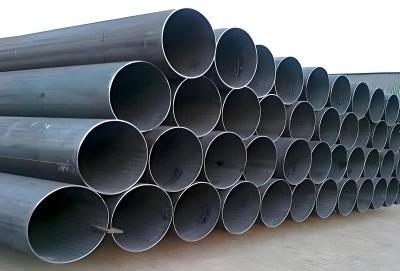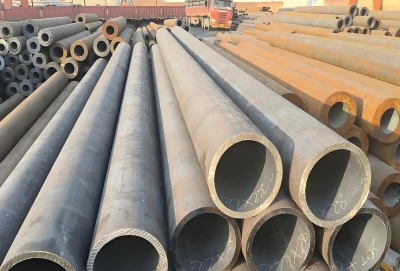When it comes to steel materials, S235 is a widely used grade that often raises questions about its classification. In this comprehensive guide, we'll explore whether S235 is indeed a carbon steel, how it's classified within carbon steel categories, its carbon content, and how it compares to other common carbon steels. Whether you're in the construction industry, manufacturing, or simply curious about steel properties, this article will provide valuable insights into S235 steel pipe and its characteristics.
|
|
|
Is S235 Classified as a Carbon Steel?
To answer the primary question: Yes, S235 is indeed classified as a carbon steel. Carbon steel is an alloy of iron and carbon, with carbon being the primary alloying element. The "S" in S235 stands for "structural steel," while the number "235" represents its minimum yield strength in megapascals (MPa).
S235 falls under the category of low carbon steel or mild steel. This classification is based on its carbon content, which plays a crucial role in determining the steel's properties and applications. Low carbon steels are known for their excellent formability, weldability, and cost-effectiveness, making them popular choices in various industries.
The classification of S235 as a carbon steel is significant because it informs engineers, manufacturers, and end-users about its general characteristics and behavior. This knowledge is essential when selecting materials for specific applications, such as in the production of S235 steel pipes for construction or industrial use.
How is S235 Classified Within Carbon Steel Categories?
Carbon steels are typically categorized based on their carbon content. The classification system helps in understanding the steel's properties and potential applications. S235 falls into the following categories:
1. Low Carbon Steel: S235 is classified as a low carbon steel. Low carbon steels contain between 0.05% and 0.25% carbon by weight. This category is known for its softness, ductility, and ease of forming and welding.
2. Mild Steel: Within the low carbon steel category, S235 is further classified as mild steel. Mild steels typically have a carbon content ranging from 0.16% to 0.29%. They offer a good balance between strength and workability, making them versatile materials for various applications.
3. Structural Steel: The "S" in S235 denotes its classification as structural steel. Structural steels are designed for use in load-bearing applications, such as in construction and infrastructure projects. They offer a combination of strength, ductility, and weldability that makes them suitable for building frameworks, bridges, and other structural components.
Understanding these classifications is crucial when considering S235 steel pipe for specific projects. The low carbon content and structural steel designation indicate that S235 can be easily welded and formed while still providing adequate strength for many applications.
What is the Carbon Content of S235?
The carbon content is a critical factor in determining a steel's properties and performance. For S235 steel, the carbon content is relatively low, which contributes to its classification as a low carbon or mild steel.
Typically, S235 steel has a maximum carbon content of 0.17% by weight. This carbon content places it firmly within the low carbon steel category. The specific carbon content can vary slightly depending on the exact grade and manufacturing specifications, but it generally remains below 0.20%.
The low carbon content in S235 steel pipe offers several advantages:
- Excellent Weldability: Lower carbon content makes S235 easier to weld without the need for preheating or post-weld heat treatment in most cases.
- Good Formability: The steel can be easily shaped and formed without cracking or excessive work hardening.
- Ductility: S235 exhibits good ductility, allowing it to deform plastically under stress without immediate fracture.
- Machinability: The relatively soft nature of S235 makes it easier to machine compared to higher carbon steels.
While the low carbon content contributes to these beneficial properties, it's important to note that it also means S235 has lower strength compared to higher carbon steels. However, for many applications, including S235 steel pipe production, this strength level is more than adequate and is offset by the material's excellent workability and cost-effectiveness.
How Does S235 Compare to Other Common Carbon Steels like S275 and S355?
To better understand the properties and applications of S235 steel pipe, it's helpful to compare it with other common carbon steels used in similar applications. Two such steels are S275 and S355. Let's examine how S235 compares to these grades:
1. Yield Strength:
- S235: Minimum yield strength of 235 MPa
- S275: Minimum yield strength of 275 MPa
- S355: Minimum yield strength of 355 MPa
As evident from their designations, S275 and S355 offer higher yield strengths compared to S235. This means they can withstand higher loads before permanent deformation occurs.
2. Carbon Content:
- S235: Maximum 0.17%
- S275: Maximum 0.25%
- S355: Maximum 0.23%
S235 has the lowest carbon content among the three, contributing to its superior weldability and formability. S275 and S355 have slightly higher carbon contents, which contribute to their increased strength.
3. Weldability:
Due to its lower carbon content, S235 generally offers the best weldability among the three grades. S275 and S355 may require more careful welding procedures, especially for thicker sections, to avoid potential issues like cold cracking.
4. Cost:
S235 is typically the most cost-effective option among the three grades. The higher strength grades (S275 and S355) usually come at a premium due to their enhanced properties.
5. Applications:
- S235: Commonly used in general structural applications, light load-bearing structures, and where formability is crucial.
- S275: Used in medium-duty structural applications where higher strength is required but formability is still important.
- S355: Preferred for heavy-duty structural applications, high-load bearing structures, and where weight savings through thinner sections is desirable.
When it comes to S235 steel pipe, its balance of properties makes it an excellent choice for many applications. While it may not offer the highest strength, its superior weldability, formability, and cost-effectiveness make it a popular choice in construction, general engineering, and various industrial applications.
It's worth noting that the choice between these steel grades often depends on specific project requirements, including load-bearing needs, fabrication methods, and budget constraints. Engineers and project managers must carefully consider these factors when selecting the most appropriate steel grade for their applications.
Choose S235 Steel Pipe
In conclusion, S235 is indeed a carbon steel, specifically classified as a low-carbon or mild steel. Its low carbon content of a maximum of 0.17% places it firmly in this category, offering excellent weldability, formability, and cost-effectiveness. While it may not match the strength of higher grades like S275 or S355, S235 pipe remains a popular choice for many structural and general engineering applications due to its balanced properties.
Understanding the characteristics and classification of S235 is crucial for making informed decisions in material selection for various projects. Whether you're considering S235 pipe for construction, industrial applications, or other uses, its properties make it a versatile and reliable choice for many scenarios.
For those seeking high-quality S235 steel pipe, Longma Group stands out as a leading manufacturer in China. With a focus on large-diameter, thick-walled, double-sided, sub-arc-seam welding steel pipes, Longma Group offers S235 pipes in grades S235JRH/J0H/J2H, with outer diameters ranging from 4" to 56" and thicknesses from 0.237" to 5.90". For more information or to discuss your specific pipe requirements, please get in touch with Longma Group at info@longma-group.com. Their commitment to excellent products and services ensures you'll receive the support and quality you need for your projects.














